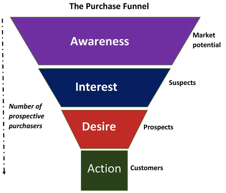This is not exactly a newsflash, but it bears emphasizing: the traditional marketing funnel needs an update for the 21st century. While it’s not completely obsolete, it does not fully encompass the journeys that leads and customers take as they interact with brands. A digital marketing funnel is more closely aligned with the more circuitous route consumers take online.

the traditional AIDA marketing funnel
 Digital marketing changed how customers and prospects approach the purchase of services and products. Brands, too, must change how they approach marketing and sales. In the past, people followed a relatively linear path from awareness to action. Today, it’s far more multi-faceted, thanks to the variety of online touchpoints available (and, of course, those in the “real” world, which should be married to provide seamless customer experiences).
Digital marketing changed how customers and prospects approach the purchase of services and products. Brands, too, must change how they approach marketing and sales. In the past, people followed a relatively linear path from awareness to action. Today, it’s far more multi-faceted, thanks to the variety of online touchpoints available (and, of course, those in the “real” world, which should be married to provide seamless customer experiences).
To put it simply, the customer’s journey is different, so companies need a revamped method by which to:
- Create targeted exposure
- Generate higher quality leads that are ready for conversion
- Nurture prospects and customers to encourage sharing, referrals, and recommendations
- Track customer purchases
- Monitor retention
- Optimize stages of the funnel that may be underperforming
A digital marketing funnel includes the following stages (again, these are not linear; consumers can go back and forth in a more fluid journey):
1. Exposure. This is similar to the concept of “awareness,” and it is a particular priority for businesses that are newly launched or hoping to break into new territory or demographics. Here, content marketing plays an invaluable role in increasing awareness and establishing your brand as a leader in its space. This is also shareable content, which further increases your reach.
2. Discovery. Once people find their way to your site, you need to make sure they stay and learn more about your product/service offerings on their way to conversion. A good website is “sticky.” That is, it offers the right type of content, at the right times, to deliver value to visitors. It also means you capture some information - if not a sale, then at least contact details - before they leave.
3. Consideration. People at this stage are edging closer to purchase. Make it a priority to address questions/problems/objections. Understanding prospects’ needs is critical in moving them along the full marketing funnel and in creating trust.
4. Conversion. Are steps leading to conversion? When consumers are ready to buy, it’s too easy to let them slip through your fingers. To ensure you do not, make the buying process simple and seamless, and that there are no gaps where you can lose them.
5. Customer Relationship. As you’ve no doubt heard, it’s more costly to attract new customers than keep existing ones (7 times more costly, in fact). Once you’ve done all this work, focus on nurturing these essential relationships. Provide top notch service, answer questions, solve problems, be accessible. You’ll differentiate yourself - and keep them coming back for more.
6. Retention. Customer retention is an ongoing effort. How will you encourage customers stay with your brand? Value. What do they need at this stage, and how can you provide it easily and in a timely manner (e.g. support calls, FAQs, how-to videos, etc.).
Each step of the digital marketing funnel is strengthened by previous and subsequent steps. When you work to optimize one (e.g. by providing excellent content during the initial stages or ongoing support during the latter), you improve them all. Remember, too, that people move between stages in a much more fluid way. They don’t go from Point A to B to C to purchase in a straight line. Expect some non-linear movement.
If you need help adjusting to and building a full funnel marketing strategy, contact the experts at THAT Agency. We’re the partners who can help you move your business to the next level.





.jpg)